形容词比较级规律总结
- 格式:doc
- 大小:46.50 KB
- 文档页数:3
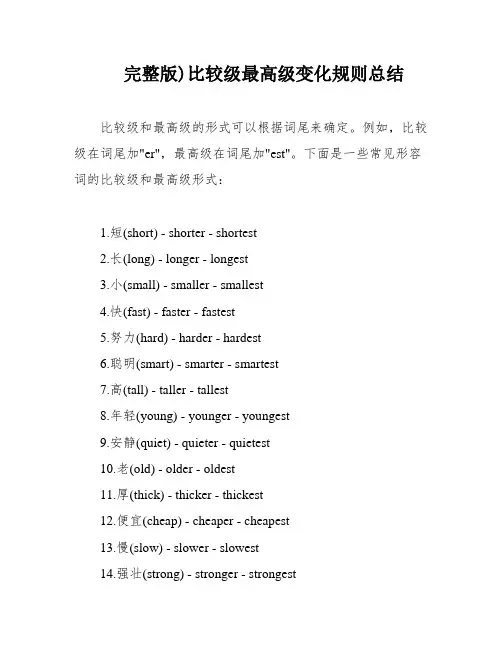
完整版)比较级最高级变化规则总结比较级和最高级的形式可以根据词尾来确定。
例如,比较级在词尾加"er",最高级在词尾加"est"。
下面是一些常见形容词的比较级和最高级形式:1.短(short) - shorter - shortest2.长(long) - longer - longest3.小(small) - smaller - smallest4.快(fast) - faster - fastest5.努力(hard) - harder - hardest6.聪明(smart) - smarter - smartest7.高(tall) - taller - tallest8.年轻(young) - younger - youngest9.安静(quiet) - quieter - quietest10.老(old) - older - oldest11.厚(thick) - thicker - thickest12.便宜(cheap) - cheaper - cheapest13.慢(slow) - slower - slowest14.强壮(strong) - stronger - strongest15.弱(weak) - weaker - weakest16.新(new) - newer - newest17.温暖(warm) - warmer - warmest18.冷(cold) - colder - coldest19.凉爽(cool) - cooler - coolest20.害羞(shy) - shyer - XXX21.紧(tight) - tighter - tightest22.干净(clean) - cleaner - cleanest23.聪明(clever) - cleverer - cleverest对于以不发音"e"结尾的单音节词,比较级直接加"r",最高级直接加"st"。
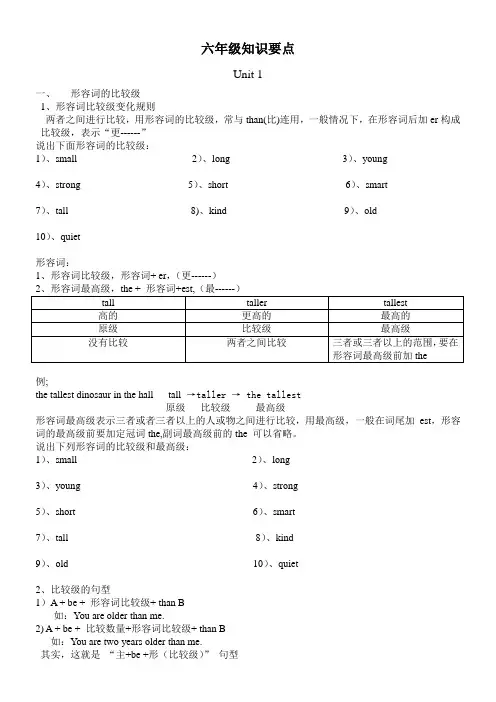
六年级知识要点Unit 1一、形容词的比较级1、形容词比较级变化规则两者之间进行比较,用形容词的比较级,常与than(比)连用,一般情况下,在形容词后加er构成比较级,表示“更------”说出下面形容词的比较级:1)、small __________ 2)、long __________ 3)、young __________ 4)、strong __________ 5)、short __________ 6)、smart __________ 7)、tall __________ 8)、kind __________ 9)、old __________ 10)、quiet __________形容词:1、形容词比较级,形容词+ er,(更------)例;the tallest dinosaur in the hall tall→taller → the tallest原级比较级最高级形容词最高级表示三者或者三者以上的人或物之间进行比较,用最高级,一般在词尾加est,形容词的最高级前要加定冠词the,副词最高级前的the 可以省略。
说出下列形容词的比较级和最高级:1)、small __________ __________ 2)、long __________ __________3)、young __________ __________ 4)、strong __________ __________5)、short __________ __________ 6)、smart __________ __________7)、tall __________ __________ 8)、kind __________ __________9)、old __________ __________ 10)、quiet __________ __________2、比较级的句型1)A + be + 形容词比较级+ than B如:You are older than me.2) A + be + 比较数量+形容词比较级+ than B如:You are two years older than me.其实,这就是“主+be +形(比较级)”句型知识拓展:比较级和最高级要同类之间进行比较Zhang Peng’s bag is bigger than Sarah’s bag. = Zhang Peng’s bag is bigger than Sarah’s. 名词所有格所修饰的词,如果前面有提到过,往往可以省略,避免重复。
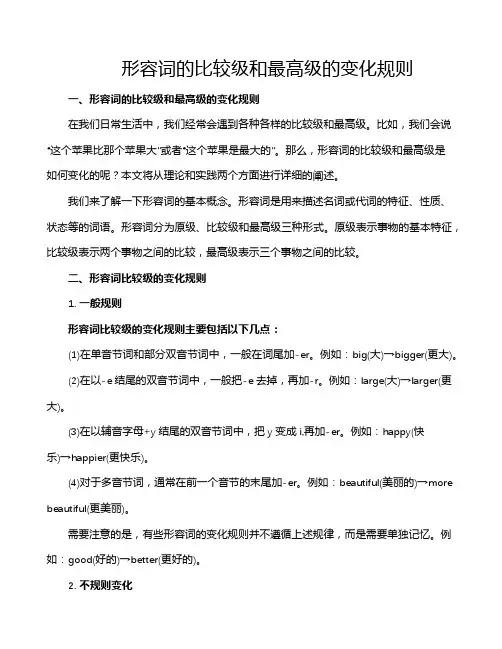
形容词的比较级和最高级的变化规则一、形容词的比较级和最高级的变化规则在我们日常生活中,我们经常会遇到各种各样的比较级和最高级。
比如,我们会说“这个苹果比那个苹果大”或者“这个苹果是最大的”。
那么,形容词的比较级和最高级是如何变化的呢?本文将从理论和实践两个方面进行详细的阐述。
我们来了解一下形容词的基本概念。
形容词是用来描述名词或代词的特征、性质、状态等的词语。
形容词分为原级、比较级和最高级三种形式。
原级表示事物的基本特征,比较级表示两个事物之间的比较,最高级表示三个事物之间的比较。
二、形容词比较级的变化规则1. 一般规则形容词比较级的变化规则主要包括以下几点:(1)在单音节词和部分双音节词中,一般在词尾加-er。
例如:big(大)→bigger(更大)。
(2)在以-e结尾的双音节词中,一般把-e去掉,再加-r。
例如:large(大)→larger(更大)。
(3)在以辅音字母+y结尾的双音节词中,把y变成i,再加-er。
例如:happy(快乐)→happier(更快乐)。
(4)对于多音节词,通常在前一个音节的末尾加-er。
例如:beautiful(美丽的)→more beautiful(更美丽)。
需要注意的是,有些形容词的变化规则并不遵循上述规律,而是需要单独记忆。
例如:good(好的)→better(更好的)。
2. 不规则变化殊,需要单独记忆。
这些不规则形容词的变化规则如下:(1)bad→worse(更糟糕)。
(2)far→farther/further(更远)。
(3)many/much→more(更多)。
(4)little→less(更少)。
三、形容词最高级的变化规则1. 一般规则形容词最高级的变化规则主要包括以下几点:(1)在单音节词和部分双音节词中,一般在词尾加-est。
例如:big(大)→biggest(最大)。
(2)在以-e结尾的双音节词中,一般把-e去掉,再加-st。
例如:large(大)→largest(最大)。
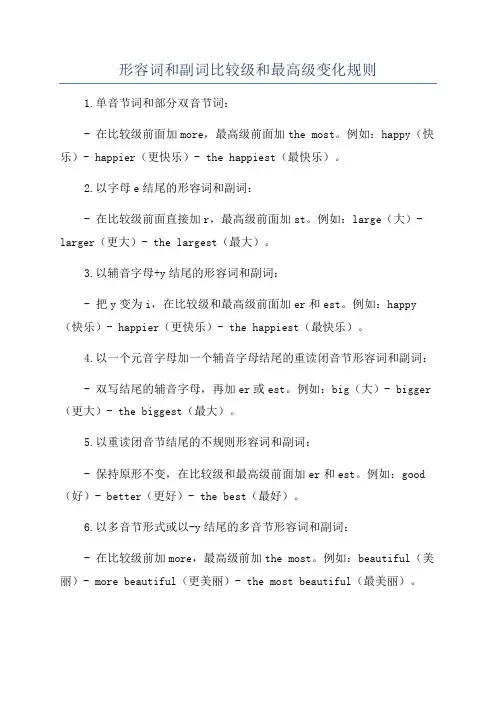
形容词和副词比较级和最高级变化规则
1.单音节词和部分双音节词:
- 在比较级前面加more,最高级前面加the most。
例如:happy(快乐)- happier(更快乐)- the happiest(最快乐)。
2.以字母e结尾的形容词和副词:
- 在比较级前面直接加r,最高级前面加st。
例如:large(大)- larger(更大)- the largest(最大)。
3.以辅音字母+y结尾的形容词和副词:
- 把y变为i,在比较级和最高级前面加er和est。
例如:happy (快乐)- happier(更快乐)- the happiest(最快乐)。
4.以一个元音字母加一个辅音字母结尾的重读闭音节形容词和副词:
- 双写结尾的辅音字母,再加er或est。
例如:big(大)- bigger (更大)- the biggest(最大)。
5.以重读闭音节结尾的不规则形容词和副词:
- 保持原形不变,在比较级和最高级前面加er和est。
例如:good (好)- better(更好)- the best(最好)。
6.以多音节形式或以-y结尾的多音节形容词和副词:
- 在比较级前加more,最高级前加the most。
例如:beautiful(美丽)- more beautiful(更美丽)- the most beautiful(最美丽)。
需要注意的是,有些形容词和副词的比较级和最高级是不规则的,需要单独记忆。
例如:bad(坏)- worse(更坏)- the worst(最坏), little(小的)- less(较小的)- the least(最小的)。
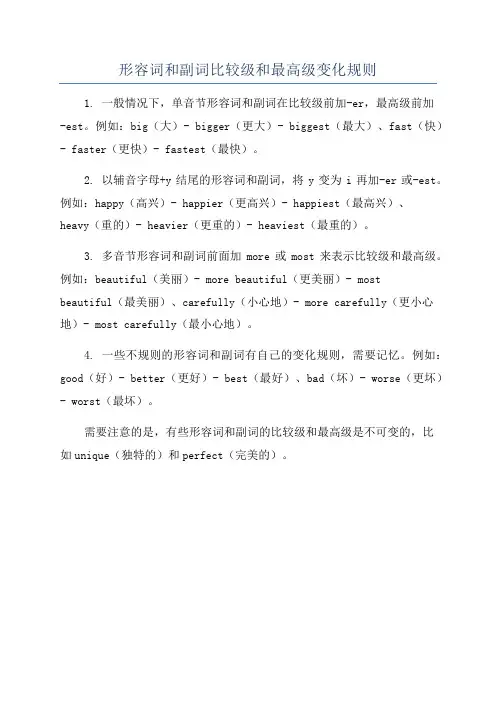
形容词和副词比较级和最高级变化规则
1. 一般情况下,单音节形容词和副词在比较级前加-er,最高级前加
-est。
例如:big(大)- bigger(更大)- biggest(最大)、fast(快)- faster(更快)- fastest(最快)。
2. 以辅音字母+y结尾的形容词和副词,将y变为i再加-er或-est。
例如:happy(高兴)- happier(更高兴)- happiest(最高兴)、
heavy(重的)- heavier(更重的)- heaviest(最重的)。
3. 多音节形容词和副词前面加more或most来表示比较级和最高级。
例如:beautiful(美丽)- more beautiful(更美丽)- most
beautiful(最美丽)、carefully(小心地)- more carefully(更小心地)- most carefully(最小心地)。
4. 一些不规则的形容词和副词有自己的变化规则,需要记忆。
例如:good(好)- better(更好)- best(最好)、bad(坏)- worse(更坏)- worst(最坏)。
需要注意的是,有些形容词和副词的比较级和最高级是不可变的,比
如unique(独特的)和perfect(完美的)。
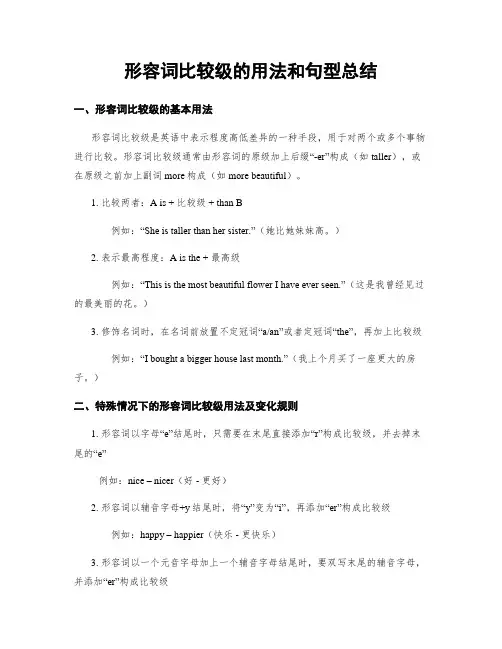
形容词比较级的用法和句型总结一、形容词比较级的基本用法形容词比较级是英语中表示程度高低差异的一种手段,用于对两个或多个事物进行比较。
形容词比较级通常由形容词的原级加上后缀“-er”构成(如taller),或在原级之前加上副词more构成(如more beautiful)。
1. 比较两者:A is + 比较级 + than B例如:“She is taller than her sister.”(她比她妹妹高。
)2. 表示最高程度:A is the + 最高级例如:“This is the most beautiful flower I have ever seen.”(这是我曾经见过的最美丽的花。
)3. 修饰名词时,在名词前放置不定冠词“a/an”或者定冠词“the”,再加上比较级例如:“I bought a bigger house last month.”(我上个月买了一座更大的房子。
)二、特殊情况下的形容词比较级用法及变化规则1. 形容词以字母“e”结尾时,只需要在末尾直接添加“r”构成比较级,并去掉末尾的“e”例如:nice – nicer(好 - 更好)2. 形容词以辅音字母+y结尾时,将“y”变为“i”,再添加“er”构成比较级例如:happy – happier(快乐 - 更快乐)3. 形容词以一个元音字母加上一个辅音字母结尾时,要双写末尾的辅音字母,并添加“er”构成比较级例如:big – bigger(大 - 更大)4. 部分形容词的比较级是不规则的,需要记忆例如:good – better(好 - 更好), bad – worse(坏 - 更坏)三、常见的形容词比较级句型1. 比较级 + and + 比较级该句型表示程度的加强,相当于中文中常用的重复表达形式。
例如:“The more you practice, the better you will become.”(你练习得越多,进步就会越大。
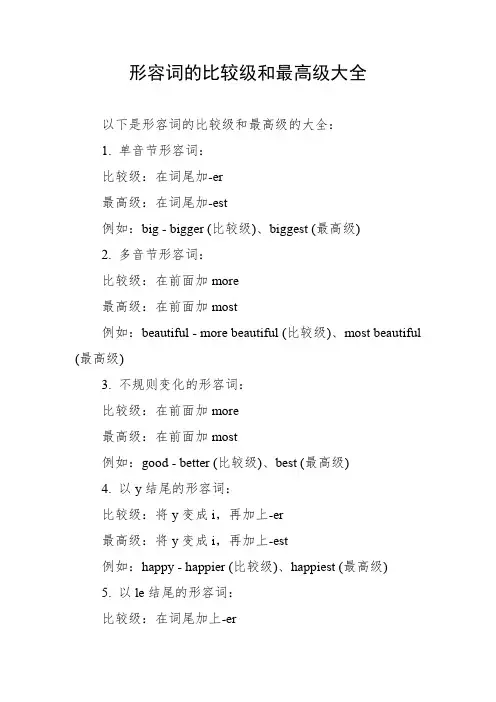
形容词的比较级和最高级大全以下是形容词的比较级和最高级的大全:1. 单音节形容词:比较级:在词尾加-er最高级:在词尾加-est例如:big - bigger (比较级)、biggest (最高级)2. 多音节形容词:比较级:在前面加more最高级:在前面加most例如:beautiful - more beautiful (比较级)、most beautiful (最高级)3. 不规则变化的形容词:比较级:在前面加more最高级:在前面加most例如:good - better (比较级)、best (最高级)4. 以y结尾的形容词:比较级:将y变成i,再加上-er最高级:将y变成i,再加上-est例如:happy - happier (比较级)、happiest (最高级)5. 以le结尾的形容词:比较级:在词尾加上-er最高级:在词尾加上-est例如:possible - more possible (比较级)、most possible (最高级)6. 少数不规则变化的形容词:比较级:在前面加more最高级:在前面加most例如:famous - more famous (比较级)、most famous (最高级)7. 特殊的比较级和最高级:例如:well - better (比较级)、best (最高级)8. 副词的比较级和最高级:比较级:在后面加-er最高级:在后面加-est例如:slowly - more slowly (比较级)、most slowly (最高级)以上是常见的形容词的比较级和最高级,但是也有一些不规则变化的形容词需要记忆。
同时,需要注意的是,有些形容词没有比较级和最高级,如unique。
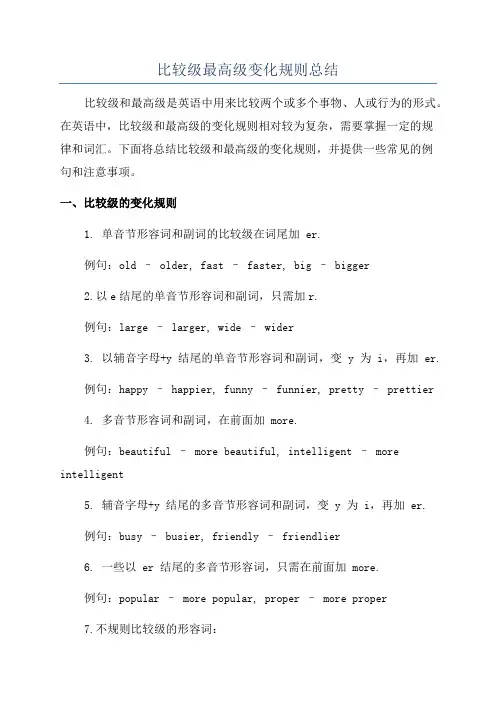
比较级最高级变化规则总结比较级和最高级是英语中用来比较两个或多个事物、人或行为的形式。
在英语中,比较级和最高级的变化规则相对较为复杂,需要掌握一定的规律和词汇。
下面将总结比较级和最高级的变化规则,并提供一些常见的例句和注意事项。
一、比较级的变化规则1. 单音节形容词和副词的比较级在词尾加 er.例句:old – older, fast – faster, big – bigger2.以e结尾的单音节形容词和副词,只需加r.例句:large – larger, wide – wider3. 以辅音字母+y 结尾的单音节形容词和副词,变 y 为 i,再加 er.例句:happy – happier, funny – funnier, pretty – prettier4. 多音节形容词和副词,在前面加 more.例句:beautiful – more beautiful, intelligent – more intelligent5. 辅音字母+y 结尾的多音节形容词和副词,变 y 为 i,再加 er.例句:busy – busier, friendly – friendlier6. 一些以 er 结尾的多音节形容词,只需在前面加 more.例句:popular – more popular, proper – more proper7.不规则比较级的形容词:多的:many – more, much – more少的:little –less, as/so … as二、最高级的变化规则1. 单音节形容词和副词的最高级在词尾加 est.例句:old – oldest, fast – fastest, big – biggest2. 以 e 结尾的单音节形容词和副词,只需加 st.例句:large – largest, wide – widest3. 以辅音字母+y 结尾的单音节形容词和副词,变 y 为 i,再加est.例句:happy – happiest, funny – funniest, pretty –prettiest4. 多音节形容词和副词,在前面加 most.例句:beautiful – most beautiful, intelligent – most intelligent5. 辅音字母+y 结尾的多音节形容词和副词,变 y 为 i,再加 est.例句:busy – busiest, friendly – friendliest6. 一些以 est 结尾的多音节形容词,只需在前面加 most.例句:popular – most popular, proper – most proper7.不规则最高级的形容词:多的:many – most, much – most少的:little – least三、注意事项1. 部分比较级和最高级形容词需要通过改变单词本身的拼写来变化。
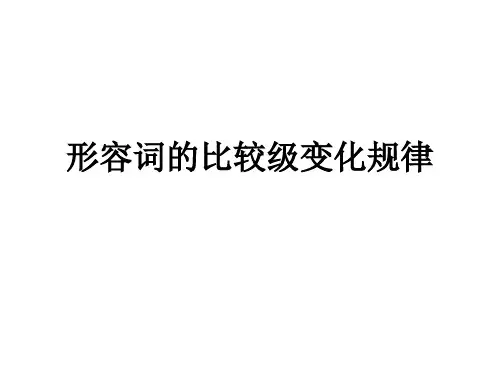
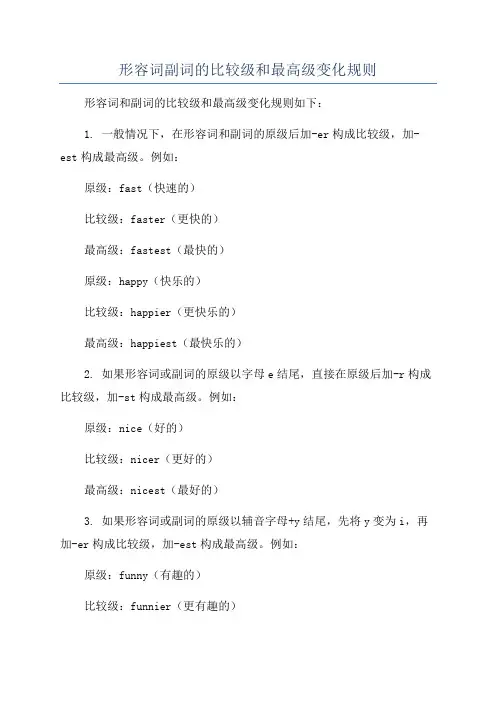
形容词副词的比较级和最高级变化规则形容词和副词的比较级和最高级变化规则如下:
1. 一般情况下,在形容词和副词的原级后加-er构成比较级,加-est构成最高级。
例如:
原级:fast(快速的)
比较级:faster(更快的)
最高级:fastest(最快的)
原级:happy(快乐的)
比较级:happier(更快乐的)
最高级:happiest(最快乐的)
2. 如果形容词或副词的原级以字母e结尾,直接在原级后加-r构成比较级,加-st构成最高级。
例如:
原级:nice(好的)
比较级:nicer(更好的)
最高级:nicest(最好的)
3. 如果形容词或副词的原级以辅音字母+y结尾,先将y变为i,再加-er构成比较级,加-est构成最高级。
例如:
原级:funny(有趣的)
比较级:funnier(更有趣的)
最高级:funniest(最有趣的)
4.一些形容词及副词的比较级和最高级形式不规则,需要进行记忆。
例如:
原级:good(好的)
比较级:better(更好的)
最高级:best(最好的)
原级:bad(坏的)
比较级:worse(更差的)
最高级:worst(最差的)
原级:far(远的)
比较级:farther(更远的)
最高级:farthest(最远的)
总的来说,形容词和副词的比较级和最高级的变化规则大致为在原级后添加-er和-est,但也有一些特殊情况需要记住。
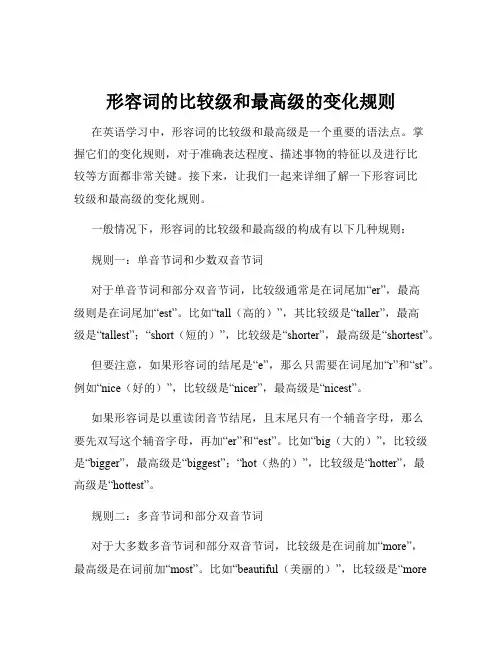
形容词的比较级和最高级的变化规则在英语学习中,形容词的比较级和最高级是一个重要的语法点。
掌握它们的变化规则,对于准确表达程度、描述事物的特征以及进行比较等方面都非常关键。
接下来,让我们一起来详细了解一下形容词比较级和最高级的变化规则。
一般情况下,形容词的比较级和最高级的构成有以下几种规则:规则一:单音节词和少数双音节词对于单音节词和部分双音节词,比较级通常是在词尾加“er”,最高级则是在词尾加“est”。
比如“tall(高的)”,其比较级是“taller”,最高级是“tallest”;“short(短的)”,比较级是“shorter”,最高级是“shortest”。
但要注意,如果形容词的结尾是“e”,那么只需要在词尾加“r”和“st”。
例如“nice(好的)”,比较级是“nicer”,最高级是“nicest”。
如果形容词是以重读闭音节结尾,且末尾只有一个辅音字母,那么要先双写这个辅音字母,再加“er”和“est”。
比如“big(大的)”,比较级是“bigger”,最高级是“biggest”;“hot(热的)”,比较级是“hotter”,最高级是“hottest”。
规则二:多音节词和部分双音节词对于大多数多音节词和部分双音节词,比较级是在词前加“more”,最高级是在词前加“most”。
比如“beautiful(美丽的)”,比较级是“morebeautiful”,最高级是“most beautiful”;“important(重要的)”,比较级是“more important”,最高级是“most important”。
规则三:不规则变化还有一些形容词的比较级和最高级是不规则变化的,需要特别记忆。
例如“good(好的)/well(好地)”,比较级是“better”,最高级是“best”;“bad(坏的)/badly(坏地)”,比较级是“worse”,最高级是“worst”;“many(许多的)/much(许多的)”,比较级是“more”,最高级是“most”;“little(少的)”,比较级是“less”,最高级是“least”;“far(远的)”,比较级有“farther(距离更远)”和“further(程度更深)”两种,最高级有“farthest(距离最远)”和“furthest(程度最深)”两种。
形容词的比较级最高级用法小结形容词的比较级和最高级是在形容词前加上“-er”和“-est”来表示。
比较级用于比较两者之间的差异,最高级则表示三个或三个以上事物之间的差异。
比较级的用法:1. 单音节形容词:- 在形容词末尾加上“-er”和“-est”。
- 例如:big(大) -> bigger(更大) -> biggest(最大)3. 以“-y”结尾的形容词:- 将“-y”改为“-ier”和“-iest”。
- 例如:happy(开心) -> happier(更开心) -> happiest(最开心)- 但是如果前面有元音字母,则直接加上“-er”和“-est”。
- 例如:playful(好玩的) -> more playful(更好玩的) -> most playful(最好玩的)4. 不规则变化:- 一些形容词的比较级和最高级是不规则的,需要记忆。
- 例如:good(好) -> better(更好) -> best(最好)bad(坏) -> worse(更坏) -> worst(最坏)3. 最高级前加上“the”:- 最高级用来表示三个或三个以上事物的区别时,需要在最高级前加上“the”。
- 例如:She is the tallest girl in the class. (她是班上最高的女孩。
)This is the most interesting book I've ever read. (这本是我读过的最有趣的书。
)小结:- 单音节形容词在末尾加上“-er”和“-est”表示比较级和最高级。
- 大部分双音节形容词在前面加上“more”和“most”表示比较级和最高级。
- 以“-y”结尾的形容词,改为“-ier”和“-iest”,或直接加上“-er”和“-est”。
- 不规则变化的形容词需要记忆比较级和最高级的形式。
- 最高级表达三个或三个以上事物之间的差异时,需要在最高级前加上“the”。
形容词副词比较级最高级变化规则及用法形容词的比较级和最高级的变化规则如下:1. 一般情况下,在形容词的原级后加-er作为比较级,加-est作为最高级。
例如:原级:tall(高)比较级:taller(更高)最高级:tallest(最高)2. 以字母“e”结尾的形容词,在原级后只加-r作为比较级,加-st作为最高级。
例如:原级:large(大的)比较级:larger(更大的)最高级:largest(最大的)3. 以元音字母加辅音字母结尾的单音节形容词,在原级后双写最后一个辅音字母,再加-er作为比较级,加-est作为最高级。
例如:原级:hot(热的)比较级:hotter(更热的)最高级:hottest(最热的)4. 以辅音字母加-y结尾的形容词,在原级中把-y改为-i,再加-er作为比较级,加-est作为最高级。
例如:原级:funny(有趣的)比较级:funnier(更有趣的)最高级:funniest(最有趣的)副词的比较级和最高级的变化规则如下:1. 大多数副词在前面加more形成比较级,在前面加most形成最高级。
例如:原级:quickly(快速地)比较级:more quickly(更快速地)最高级:most quickly(最快速地)2. 以字母“e”结尾的副词,在前面只加-r形成比较级,加-st形成最高级。
例如:原级:late(迟)比较级:later(更迟)最高级:latest(最迟)3. 以字母“y”结尾的副词,在前面把-y改为-i,再加-er形成比较级,加-est形成最高级。
例如:原级:busy(忙碌地)比较级:busier(更忙碌地)最高级:busiest(最忙碌地)需要注意的是,有些形容词和副词的比较级和最高级形式并不遵循以上的规则,而是需要记忆。
例如:good(好的)- better(更好的)- best(最好的), well(好地)- better(更好地)- best(最好地)。
形容词比较级大全总结形容词是我们日常生活中经常使用的词语,形容词的比较级用于表示比较两个或多个事物的特征或属性。
比较级的运用可以使我们的语言更加生动有力,让描述更加准确。
本文将为您总结一些常见的形容词比较级,希望对您的写作和表达能起到一定的帮助。
一、单音节形容词的比较级对于单音节形容词,我们可以直接在形容词后面加上-er来构成其比较级。
以下是一些常见的单音节形容词比较级的例子:1.hot(热)→ hotter(更热)2.cold(冷)→ colder(更冷)3.tall(高)→ taller(更高)4.short(矮)→ shorter(更矮)5.long(长)→ longer(更长)6.old(老)→ older(更老)需要注意的是,以一个辅音字母加y结尾的形容词,要在比较级中将y变为i,再加-er构成比较级。
例如:1.happy(高兴)→ happier(更高兴)2.angry(生气)→ angrier(更生气)3.easy(容易)→ easier(更容易)二、双音节形容词的比较级对于双音节形容词,一般是在词前加上more(更)构成比较级。
以下是一些常见的双音节形容词比较级的例子:1.beautiful(美丽)→ more beautiful(更美丽)2.expensive(昂贵)→ more expensive(更昂贵)3.interesting(有趣)→ more interesting(更有趣)4.important(重要)→ more important(更重要)5.intelligent(聪明)→ more intelligent(更聪明)6.polite(礼貌)→ more polite(更礼貌)需要注意的是,有一些双音节形容词的比较级是通过改变形容词的词根来构成的。
例如:1.good(好)→ better(更好)2.bad(坏)→ worse(更坏)3.little(小)→ less(更小)三、三音节及以上形容词的比较级对于三音节及以上的形容词,一般也是在词前加上more(更)构成比较级,或者通过改变形容词的词根来构成比较级。
形容词比较级的变化规则全音解释1. 简介形容词比较级的变化规则是汉语语法中一个重要且复杂的部分,掌握好比较级的变化规则对于正确使用汉语形容词至关重要。
本文将从全音解释的角度出发,对形容词比较级的变化规则进行解析,帮助读者更好地理解和掌握这一知识点。
2. 形容词的比较级形容词的比较级表示两者之间的程度、大小或者质量的比较,是汉语中常见的语法结构之一。
比较级的构成有一定的规则,一般来说,单音节形容词和少数双音节形容词可以直接在词尾加“-er”来构成比较级,如“高”变成“更高”,“贵”变成“更贵”。
3. 双音节形容词的比较级对于双音节形容词,比较级的构成稍显复杂,需要根据不同的音节结构和重音位置来进行变化。
一般来说,重读音节在形容词词尾时,要在词尾加上“-er”,如“美丽”变成“更美丽”,而重读音节在形容词词首时,要在形容词前加“更”,如“干净”变成“更干净”。
4. 问题分析形容词比较级的变化规则虽然看似简单,但其中却隐藏着许多细节和例外情况,容易让人感到困惑。
不同方言和口音的影响也会影响比较级的变化规则,使其更加复杂化。
需要在实际应用中不断练习和总结,才能熟练掌握形容词比较级的变化规则。
5. 全音解释全音解释是一种语音学的观点,提出语音现象是和整个词的音节结构有关,是对音节结构的一种解释。
在形容词比较级的变化规则中,全音解释可以帮助我们更好地理解形容词词尾或词首加“-er”或“更”时的规律性变化。
6. 音节结构对比较级的影响全音解释认为,形容词的比较级在构成过程中会受到音节结构的影响。
当形容词的词尾为重读音节时,可以直接加上“-er”来构成比较级;而当形容词的词首为重读音节时,需要在形容词前加“更”来构成比较级。
这种区别是由音节结构所决定的,是一种规律性的变化。
7. 实例分析以“漂亮”这个形容词为例,根据全音解释,可以知道“漂亮”的词尾为重读音节,因此可以直接在词尾加上“-er”来构成比较级,变成“更漂亮”;而以“干净”这个形容词为例,根据全音解释,可以知道“干净”的词首为重读音节,因此需要在形容词前加“更”来构成比较级,变成“更干净”。
形容词的比较级和最高级的变化规则在英语学习中,形容词的比较级和最高级是一个重要的语法知识点。
掌握它们的变化规则,对于准确表达程度和进行比较非常关键。
下面就让我们一起来详细了解一下形容词的比较级和最高级的变化规则。
一般来说,形容词的比较级和最高级的变化可以分为规则变化和不规则变化两大类。
先来看规则变化。
第一种规则是单音节和部分双音节形容词,在词尾加 er 构成比较级,加 est 构成最高级。
比如,“tall(高的)”这个单词,其比较级是“taller”,最高级是“tallest”;“short(短的)”的比较级是“shorter”,最高级是“shortest”。
对于以字母 e 结尾的形容词,直接在词尾加 r 构成比较级,加 st 构成最高级。
例如,“nice(美好的)”,比较级是“nicer”,最高级是“nicest”;“wide(宽的)”,比较级是“wider”,最高级是“widest”。
如果形容词是以重读闭音节结尾,且末尾只有一个辅音字母,那么要先双写这个辅音字母,再加 er 构成比较级,加 est 构成最高级。
比如,“big(大的)”,比较级是“bigger”,最高级是“biggest”;“hot(热的)”,比较级是“hotter”,最高级是“hottest”。
还有一种情况,对于以“辅音字母+y”结尾的形容词,要先把 y 变为 i,再加 er 构成比较级,加 est 构成最高级。
像“happy(快乐的)”,比较级是“happier”,最高级是“happiest”;“busy(忙碌的)”,比较级是“busier”,最高级是“busiest”。
部分双音节和多音节形容词,则在前面加 more 构成比较级,加most 构成最高级。
比如,“beautiful(美丽的)”,比较级是“more beautiful”,最高级是“most beautiful”;“important(重要的)”,比较级是“more important”,最高级是“most important”。
形容词副词变比较级规律
形容词和副词的比较级变化规则如下:
1.规则变化:
∙单音节形容词和部分双音节形容词,在末尾加上-er,如:calm→calmer,smart→smart er,fast→faster,high→higher。
∙以不发音的e结尾的形容词,直接在词尾加-r,如:nice→nicer,fine→finer,wide→wi der。
∙以辅音字母+y结尾的形容词,把y变为i再加-er,如:early→earlier,happy→happie r,easy→easier。
∙以重读闭音节的单个辅音字母结尾的形容词,双写辅音字母再加-er,如:big→bigger,t hin→thinner,hot→hotter。
∙多音节形容词和部分双音节形容词,在词前加more,如:beautiful→more beautiful,i nteresting→more interesting。
∙由“动词-ing和动词-ed”构成的形容词,在前面加more构成比较级,如:interesting →more interesting,bored→more bored。
∙由“形容词+后缀-ly”构成的副词,在该副词前面加上more构成比较级,如:slowly→more slowly,happily→more happily。
2.不规则变化:
一些形容词的比较级是不规则的,需要单独记忆,如:good→better,bad→worse。
总的来说,英语中形容词和副词的比较级变化规则大部分是规则的,但也有一些不规则的变化需要额外注意和学习。
形容词比较级规律总结-标准化文件发布号:(9556-EUATWK-MWUB-WUNN-INNUL-DDQTY-KII
一.形容词比较级的规则变化规律:
1,一般形容词直接加er,如:
Small—smaller—the smallest old—older---the oldest
Short—shorter—the shortest tall—taller—the tallest
Long—longer—the longest fast—faster—the fastest
Cold—colder—the coldest new—newer—the newest
2,以e结尾的形容词直接加r,如:
Wide—wider—the widest nice—nicer—the nicest
3,以元音字母+辅音字母结尾的形容词,双写词尾字母加er,如:
Big—bigger—the biggest fat—fatter—the fattest
Hot---hotter---the hottest wet—wetter---the wettest
4,以y结尾的形容词要去掉y,加ier,如:
Happy---happier—happiest heavy---heavier---heaviest
dry---drier---the driest
5,多音节词,部分双音节形容词前加more变比较级,加the most变最高级,如:
Beautiful—more beautiful—the most beautiful
二.形容词比较级的不规则变化:
good/well--better--best
bad—worse—worst
many/much—more—most
little—less—least。